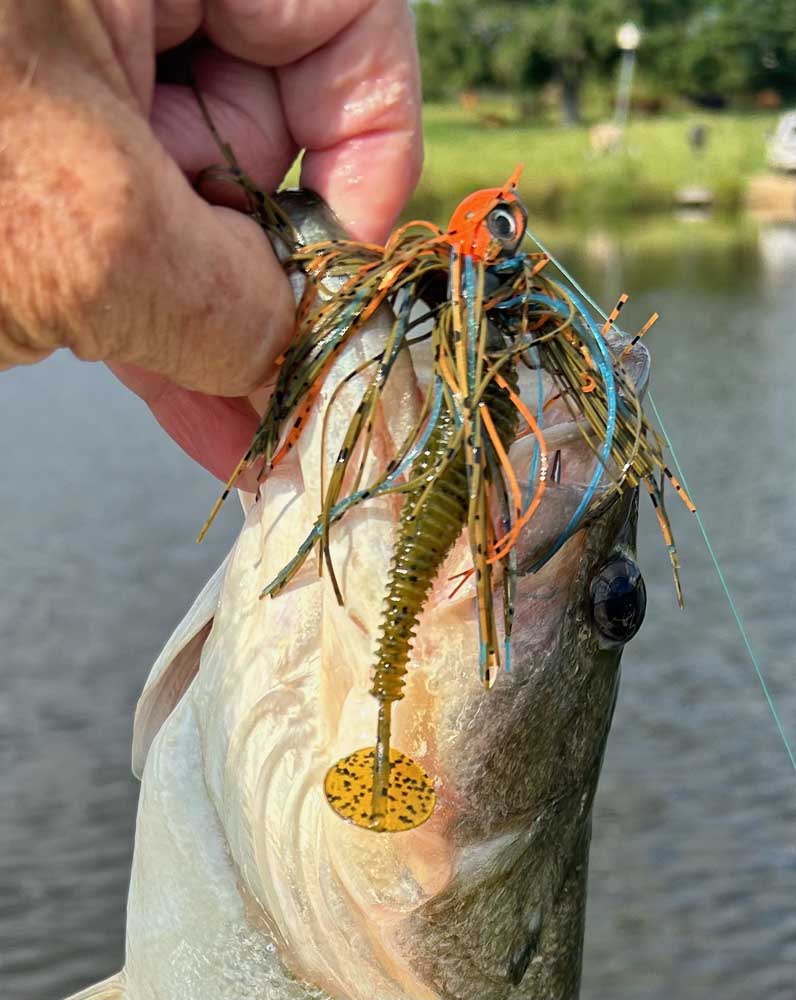In the Swim: When all else fails, a swim jig can be the summer bass answer
Published 11:21 pm Friday, July 26, 2024

- During the summer when the water heats up and bass slow down their activity a swim jig can be effective for fish feeding on bream or shad in shallow water. (Steve Knight/Tyler Morning Telegraph)
Bass fishermen have a lot of tools in their tackle box, and many more in the tackle shop if they ever need another option.
Budget and familiarity are often the limiting factor on just how many techniques a fisherman attempts to master. However, when the bite slows down and you have been through everything in your tackle box that you have faith in, it’s time to head to the store for another bait or two.
Facing the normal summertime slump I followed a recommendation from a friend and started using Chatterbaits. They have been around for decades, but it’s just a lure I never had much luck on and quickly abandoned in the past. This time around, using chartreuse and blue, a chartreuse trailer and adopting a slow roll, I began to get bites. Getting a hook set was something different because it is different from a soft plastic or crankbait.
Eventually, I got the hang of it, and continued to fish it until it started to slow. Suddenly open to new things, I switched to a swim jig, another long-tested bait that I have shied away from because of my lack of mastery of all things jigs.
What I learned is that the swim jig is not only simple to fish, but it also produces bass in the hottest of water when nothing else will.
Texas Major League Fishing pro Jeff Sprague said the swim jig is something that can be used from April through October, but really shines in the heat of summer when bass have slowed and are selective eaters.
“The fish, a lot of times, have started feeding back on bream. Bream are getting back on beds or the thermocline pushes them back into shallow water,” Sprague explained.
He added the swim jig is most effective as a shallow water bait.
“Two- to three-feet is as deep as I fish it,” Sprague said.
This makes the lure perfect for fishing flats.
“The flats, that is where the bluegill go to feed. They are hunting grasshoppers, fry, bug larvae or whatever. Around lily pads and lay downs is where bass try to find them,” Sprague said.
Like with any lure, especially in the summer months, what worked one day is not necessarily the ticket the next, or in a different location. Sprague said there are days he will steady slow-roll it and let it bump over grass and stumps, or he uses a fast retrieve so the bass don’t get a good look at the lure and go for a reaction strike.
The one constant, however, is color, bream or shad, with the occasional black and blue for black-stained waters.
Sprague also modifies his jigs’ appearance.
“I like to trim a quarter- or half-inch off the skirt so the appendages on the back have fluid motion and it is cleaner so they are able to see the trailer,” Sprague said.
As for trailers, he sticks with homegrown, using a couple of options from Lake Fork Tackle.
“Some work better than other. I like the Lake Fork Magic Shad Boot Tail. The orange color looks like a bream and there is also a shad color,” Sprague said.
His other option is his own design, the Lake Fork Pro Craw, that will be available at the Lake Fork Lure store beginning Aug. 1. The Lake Fork Pro Craw is a twin-tail lure that works especially well fishing it high in the water.
In setting up the swim jig, Sprague also trims the brush guard, which he said makes it stiffer and even more weedless.
“A swim jig is a stick I keep in my hand all day. Starting in the morning in the summer I have a buzz bait, a swim jig and a frog, and I alternate the three to see which they prefer. They will let you know in the first hour and you can kind of keep that one in your hand,” Sprague said.
As day goes along, he uses it to fish shadows.
There is a learning curve on a swim jig bite. Bigger fish will hit it with a vengeance to conserve energy while eating. When a smaller fish hits it is can feel more like hanging up on grass on the bottom.
“Smaller bass don’t think it is as large as it is until they get up on it and when they do they slap at the skirt or trailer,” Sprague said.
— Contact Knight at outdoor@tylerpaper.com






